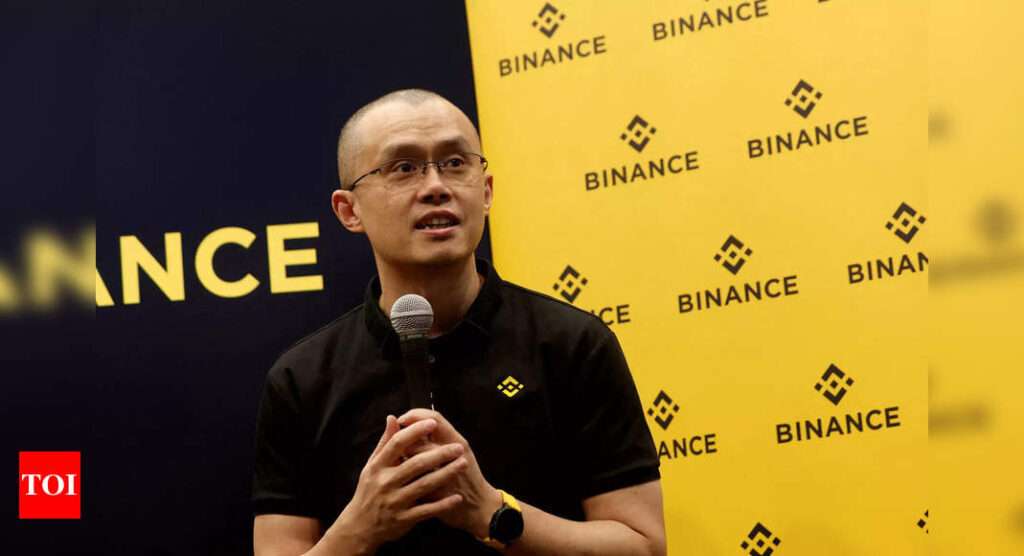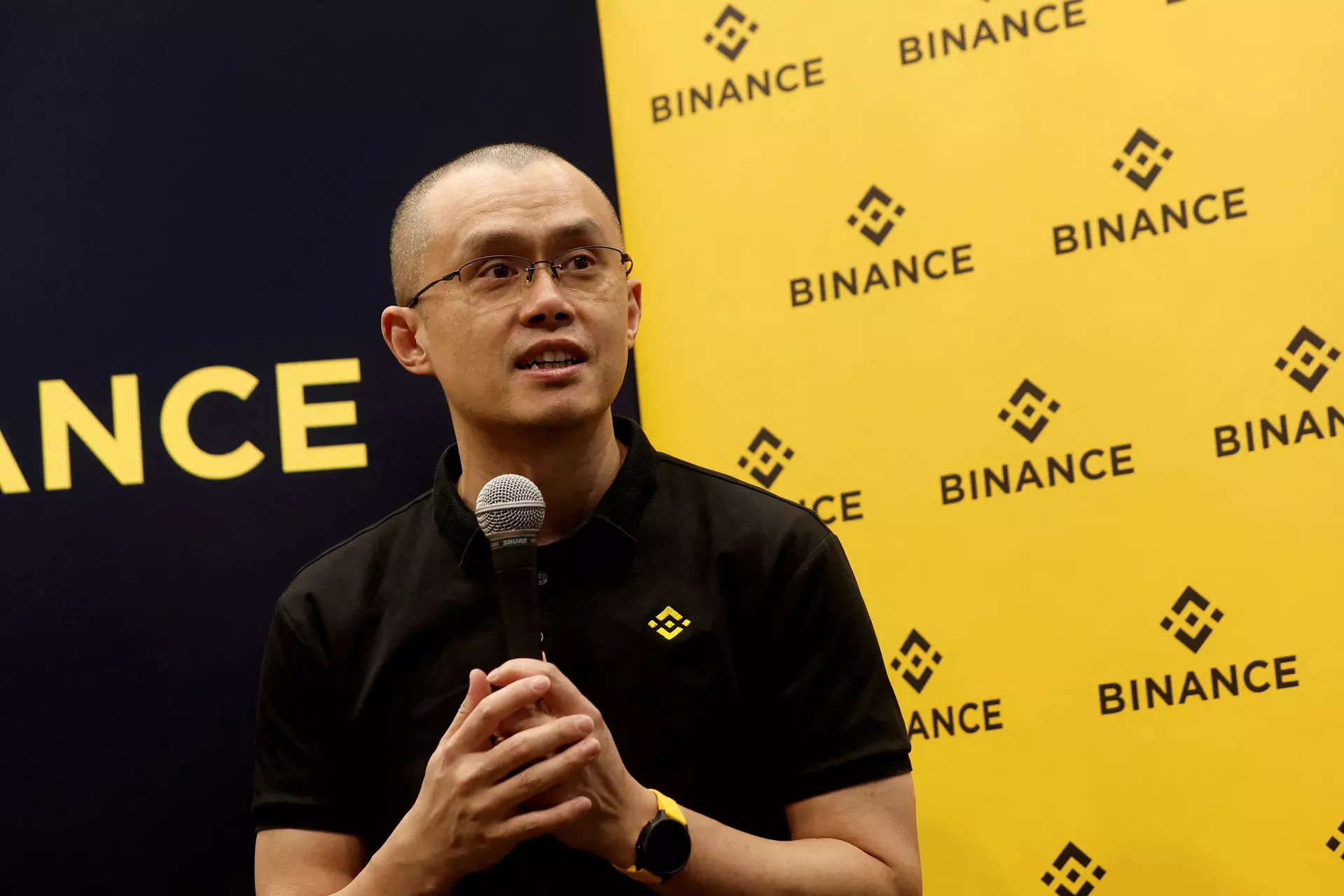[ad_1]
Changpeng Zhao had long cultivated the image of the rugged pugilist of the cryptocurrencies world.
When his rival Sam Bankman-Fried’s crypto empire collapsed a year ago, Zhao, or “CZ” as his fans call him, was in the middle of it all, yanking his money in a very public way and helping trigger the ultimately fatal run on the firms. Years earlier he claimed the company’s headquarters was wherever he happened to be, a thinly veiled salvo against regulators trying to nail down jurisdiction.And this March, when US regulators charged Zhao and his firm,Binance Holdings, with violating US securities laws, his on-line response was “4,” which is Zhao code for dismissing something as unworthy of his attention.
On Tuesday, though, Zhao cut a very different image in a Seattle courtroom. Dressed in dark suit and pale blue tie before a federal judge, he pleaded guilty to criminal charges for anti-money laundering and US sanctions violations, including allowing transactions with Hamas and other terrorist groups, under a sweeping deal with the Justice department designed to keep the biggest crypto exchange operating. Binance itself agreed to plead guilty to criminal charges and pay over $4 billion in penalties. Zhao stepped down as CEO and will pay a $50 million fine.
Zhao’s capitulation in many ways is the culmination of a multi-year dragnet by international regulators who sought to rein in and impose regulations on Binance — and, by extension, the broader industry.
Moreover, it marks the second time in less than a year that the crypto universe, still reeling from a crash that shaved some $2 trillion off the value of the market, loses one of its biggest stars. Bankman-Fried may have been the best known name in crypto but Zhao, worth almost $100 billion at his zenith in early 2022, was the wealthiest and most powerful.
“This is a big deal,” said Michael Rosen, chief investment officer at Angeles Investments. Zhao’s “prominence helped him until it hurt him,” converting him eventually into a big target for authorities.
Richard Teng, a civil servant-turned-crypto executive, succeeded Zhao.
Binance Coin, a cryptocurrency also known as BNB that is the main transactional token on the exchange, dropped more than 8% on Tuesday.
Zhao played a key role in bringing cryptocurrencies into the mainstream. He built Binance into a juggernaut that at one point controlled almost two-thirds of spot trading over centralized exchanges — attracting scrutiny from regulators and law enforcement agencies around the world along the way.
The departure of crypto’s perhaps most iconic remaining executive comes as the industry tries to put its reputation for scandals, scams and other illicit activities behind it. Several entrepreneurs associated with that era, from Bankman-Fried to Do Kwon and Alex Mashinsky, are either in jail or have been charged with alleged crimes that led to multibillion-dollar losses.
Zhao faces as many as 10 years in prison but is expected to get no more than 18 months under a plea deal that appears to have saved him from the harsh penalties that other prominent crypto criminals have faced. The Justice Department hasn’t decided yet what length of a prison term they will seek for him.
Born in China, Zhao moved to Vancouver when he was 12 and became a Canadian citizen. With a computer science degree from McGill University, he began a career building trading systems, including a stint at Bloomberg LP, the parent company of Bloomberg News.
In 2013, Zhao was running his own software company in Shanghai when he discovered Bitcoin over a poker game. After working at crypto firms Blockchain.info and OKCoin, he started Binance in 2017 together with Chief Marketing Officer Yi He, with whom he has children.
Binance quickly embarked on an acquisition spree that saw it morph into a brokerage, digital wallet, venture fund, custody service, data provider, digital-art marketplace and token issuer — all under Zhao’s direct control.
Within just a few years, Zhao was the richest person in crypto. Favoring a buzz cut and black polo shirts featuring Binance’s logo, he became a fixture on the crypto conference circuit, spending 580 hours on airplanes in 2022 by his own estimate.
The lack of separation between business actives such as custodial and trading services common among crypto exchanges, unlike in traditional finance — has stirred concerns that giant crypto exchanges like Binance could pose systemic risks.
When Bankman-Fried’s FTX imploded in November 2022, billions of dollars of client funds were trapped because FTX had lent assets to the hedge fund he also controlled, Alameda Research, which had made huge losing bets. Zhao himself helped hasten FTX’s demise with a post on Twitter about selling Binance’s holding of its native token FTT, which touched off a stampede to withdraw money from FTX.
Bankman-Fried was convicted of a massive fraud in early November and is awaiting sentencing. He faces the possibility of decades in prison.
Binance and other exchanges have argued that they present no similar risks because all of their client assets are kept separated and thus available for withdrawal at any time. Zhao himself regularly uses the term “SAFU” in tweets to assure customers that their funds are safe.
In the third quarter, the exchange has accounted for about 38% of all trading volumes across the spot market, down from nearly 55% in the first quarter of the year, according to researcher CCData. By comparison, Coinbase Global Inc., the biggest US crypto exchange, had a 5.7% market share in the quarter.
While Zhao publicly displayed defiance amid the charges, Binance authorities were working with regulators behind the scenes. Even Zhao’s official statement back in March was a bit more conciliatory than his “4” tweet, saying the firm was looking for “amicable solutions.”
The 4 tweet quickly became a favorite of his on-line detractors Tuesday. It actually represented, they snickered, the $4 billion fine Binance would pay.
When his rival Sam Bankman-Fried’s crypto empire collapsed a year ago, Zhao, or “CZ” as his fans call him, was in the middle of it all, yanking his money in a very public way and helping trigger the ultimately fatal run on the firms. Years earlier he claimed the company’s headquarters was wherever he happened to be, a thinly veiled salvo against regulators trying to nail down jurisdiction.And this March, when US regulators charged Zhao and his firm,Binance Holdings, with violating US securities laws, his on-line response was “4,” which is Zhao code for dismissing something as unworthy of his attention.
On Tuesday, though, Zhao cut a very different image in a Seattle courtroom. Dressed in dark suit and pale blue tie before a federal judge, he pleaded guilty to criminal charges for anti-money laundering and US sanctions violations, including allowing transactions with Hamas and other terrorist groups, under a sweeping deal with the Justice department designed to keep the biggest crypto exchange operating. Binance itself agreed to plead guilty to criminal charges and pay over $4 billion in penalties. Zhao stepped down as CEO and will pay a $50 million fine.
Zhao’s capitulation in many ways is the culmination of a multi-year dragnet by international regulators who sought to rein in and impose regulations on Binance — and, by extension, the broader industry.
Moreover, it marks the second time in less than a year that the crypto universe, still reeling from a crash that shaved some $2 trillion off the value of the market, loses one of its biggest stars. Bankman-Fried may have been the best known name in crypto but Zhao, worth almost $100 billion at his zenith in early 2022, was the wealthiest and most powerful.
“This is a big deal,” said Michael Rosen, chief investment officer at Angeles Investments. Zhao’s “prominence helped him until it hurt him,” converting him eventually into a big target for authorities.
Richard Teng, a civil servant-turned-crypto executive, succeeded Zhao.
Binance Coin, a cryptocurrency also known as BNB that is the main transactional token on the exchange, dropped more than 8% on Tuesday.
Zhao played a key role in bringing cryptocurrencies into the mainstream. He built Binance into a juggernaut that at one point controlled almost two-thirds of spot trading over centralized exchanges — attracting scrutiny from regulators and law enforcement agencies around the world along the way.
The departure of crypto’s perhaps most iconic remaining executive comes as the industry tries to put its reputation for scandals, scams and other illicit activities behind it. Several entrepreneurs associated with that era, from Bankman-Fried to Do Kwon and Alex Mashinsky, are either in jail or have been charged with alleged crimes that led to multibillion-dollar losses.
Zhao faces as many as 10 years in prison but is expected to get no more than 18 months under a plea deal that appears to have saved him from the harsh penalties that other prominent crypto criminals have faced. The Justice Department hasn’t decided yet what length of a prison term they will seek for him.
Born in China, Zhao moved to Vancouver when he was 12 and became a Canadian citizen. With a computer science degree from McGill University, he began a career building trading systems, including a stint at Bloomberg LP, the parent company of Bloomberg News.
In 2013, Zhao was running his own software company in Shanghai when he discovered Bitcoin over a poker game. After working at crypto firms Blockchain.info and OKCoin, he started Binance in 2017 together with Chief Marketing Officer Yi He, with whom he has children.
Binance quickly embarked on an acquisition spree that saw it morph into a brokerage, digital wallet, venture fund, custody service, data provider, digital-art marketplace and token issuer — all under Zhao’s direct control.
Within just a few years, Zhao was the richest person in crypto. Favoring a buzz cut and black polo shirts featuring Binance’s logo, he became a fixture on the crypto conference circuit, spending 580 hours on airplanes in 2022 by his own estimate.
The lack of separation between business actives such as custodial and trading services common among crypto exchanges, unlike in traditional finance — has stirred concerns that giant crypto exchanges like Binance could pose systemic risks.
When Bankman-Fried’s FTX imploded in November 2022, billions of dollars of client funds were trapped because FTX had lent assets to the hedge fund he also controlled, Alameda Research, which had made huge losing bets. Zhao himself helped hasten FTX’s demise with a post on Twitter about selling Binance’s holding of its native token FTT, which touched off a stampede to withdraw money from FTX.
Bankman-Fried was convicted of a massive fraud in early November and is awaiting sentencing. He faces the possibility of decades in prison.
Binance and other exchanges have argued that they present no similar risks because all of their client assets are kept separated and thus available for withdrawal at any time. Zhao himself regularly uses the term “SAFU” in tweets to assure customers that their funds are safe.
In the third quarter, the exchange has accounted for about 38% of all trading volumes across the spot market, down from nearly 55% in the first quarter of the year, according to researcher CCData. By comparison, Coinbase Global Inc., the biggest US crypto exchange, had a 5.7% market share in the quarter.
While Zhao publicly displayed defiance amid the charges, Binance authorities were working with regulators behind the scenes. Even Zhao’s official statement back in March was a bit more conciliatory than his “4” tweet, saying the firm was looking for “amicable solutions.”
The 4 tweet quickly became a favorite of his on-line detractors Tuesday. It actually represented, they snickered, the $4 billion fine Binance would pay.
[ad_2]
Source link











More Stories
India’S Growth Forecast: S&P ups India’s FY’24 growth forecast to 6.4% on robust domestic momentum
India to remain fastest-growing major economy, but demand uneven: Poll
Jack Ma: Jack Ma gets back into business with ‘Ma’s Kitchen Food’